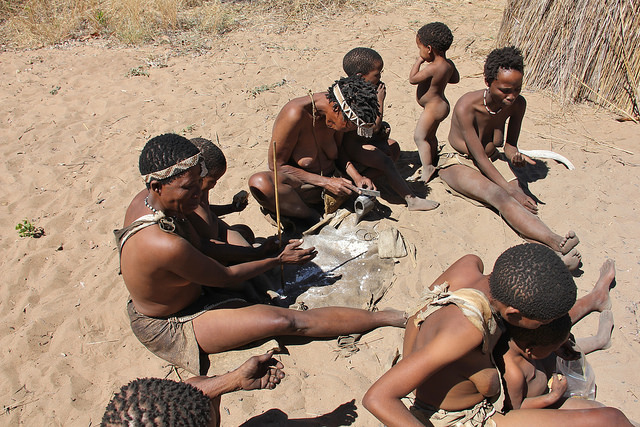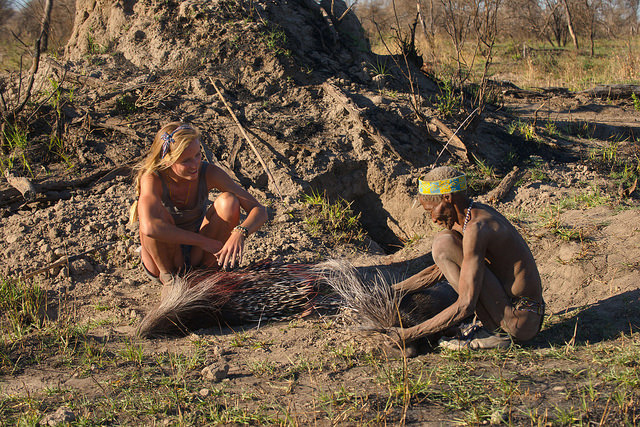The Nanofasa Conservation Trust in Namibia has gotten a significant amount of funding to help it set up a “Barefoot Academy” for the Ju/’hoansi. The organization’s 2014 Annual Report, dated March 3, 2015 and available on its website, stated as one of its goals for the coming year that it wanted to “set up [a] Barefoot Academy / and get the first guys through training to become tracking teachers / Barefoot mentors.”

Issue number 2 of their newsletter, also available on the website and dated November 30, 2015, indicated that the organization was moving rapidly forward to establish its academy with a broader purpose than the annual report had envisioned. As of November, five Ju/’hoansi men and six boys were building the training center, which is being designed to conserve nature, and particularly the wildlife resources in the area, as well as to promote the continuation of the local, traditional culture through training programs for Ju/’hoansi youths. In the process, it is trying to provide work for men, women, and unemployed young people.
Last week, a news story in The Namibian, a major newspaper in that country, reported that Bank Windhoek has sponsored the founding of the Barefoot Academy with an initial grant of N$190.000 (US$11,500). The news report pointed out that the Nanofasa Conservation Trust (called the “Nanofasa Namibia Trust” by the reporter) was founded in 2011 by Aleksandra Ørbeck-Nilssen with a goal of protecting, managing and sustaining the cultural and natural integrity of the Ju/’hoansi San people who live in the Nyae Nyae Conservancy.
The reporter focused on the new academy, which will have three complementary programs based in the Ju/’hoansi villages. The first, the Hunter Program, will seek to encourage older hunters to pass along their indigenous knowledge, particularly about nature, to students. Their knowledge of wildlife, rituals, traditional methods of hunting, the fabrication of tools, topography, ecology, and of course hunting techniques, will be among the skills taught by the elders to young people.
Ørbeck-Nilssen told the paper, “The students will also learn the art of tracking and reading nature signs and will have to pass practical traditional and tracking exams to gain a certificate.” The certification will allow the students to become guides and trackers, so they can help with research projects, hunting parties, and conservation work. The names of the students will be added to a database that the organization will maintain for potential employers to use when they are searching for candidates for positions.
The second section of the new academy will be the Gathering Program, to be run by elderly Ju/’hoansi women, who will teach students traditional ways of gathering foods in the bush. They will also concentrate on rituals, storytelling, the sustainable uses of resources, and the production of traditional crafts.

After those students complete an exam, they will be certified as bush scientists, according to The Namibian, or as makers of crafts, research assistants, or vegetation assessors.
The third program will be a Healer Academy, Ørbeck-Nilssen explained. In that program, older healers will pass along their knowledge of healing techniques employing traditional approaches, such as the use of plants and their roots. The program will emphasize the sustainable uses of those wild resources.
The Barefoot Academy also plans to teach young people ways of growing plants in greenhouses built primarily from recycled plastic beverage bottles. Ørbeck-Nilssen told The Namibian that this was a way to make sure the construction of each greenhouse was as environmentally friendly as possible. She said that malnutrition is a problem among the San people, and the greenhouses will help provide backup food sources during drought periods.
The newspaper article highlights the Barefoot Academy, and the Nanofasa Conservation Trust, by quoting Riaan van Rooyen, the head of corporate communications and social investments at Bank Windhoek. “The combination of preserving the heritage of the San communities along with the skills transfer and potential for job creation and nature conservation from this project, is phenomenal,” he said.
The official went on to explain that the project effectively captures the principal focus areas of the bank: education, training, job creation, and entrepreneurship. Van Rooyen emphasized that the creation of the database will encourage employers to find skilled workers in fields related to the sustainable uses of natural resources, conservation, and research. The newsletter of November 30, 2015, makes it clear that the Barefoot Academy has been created “in conjunction with the communities themselves, where we base the project on their interests and knowledge…”

The Nanofasa website says that Aleksandra Ørbeck-Nilssen is a 24-year old former Norwegian model and actress who has experience in New York and Paris. She traveled to Namibia and was so taken with the country, its people, and its wildlife, that she has dedicated her life to it and to the San of Nyae Nyae. The website also profiles the other Europeans and Namibians who are closely involved with the projects of the organization, of which the Barefoot Academy is only one.
As a publicity and fund-raising venture in 2016, and to showcase the indigenous knowledge of the Ju/’hoansi, Ørbeck-Nilssen is planning to walk a distance of 1,200 km from the coast of Namibia inland to a San village, accompanied by a San hunter and a young San boy. She will also be accompanied by a film crew. Her obsessions with keeping the traditional ways of the San relevant in today’s world, and teaching them to the younger generation, should make for an interesting film.